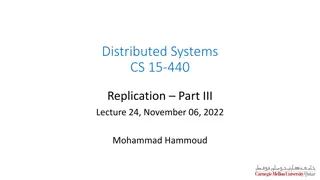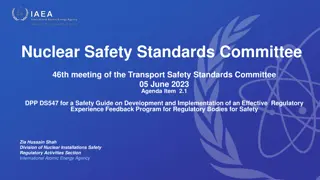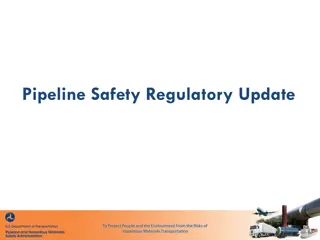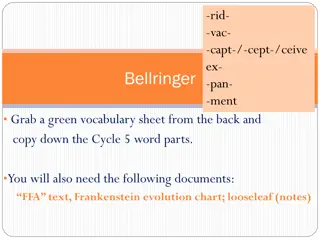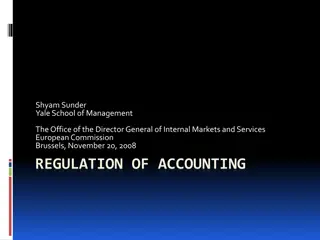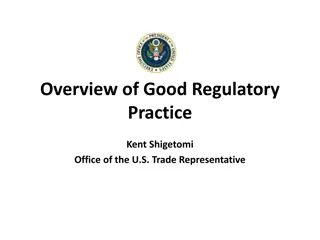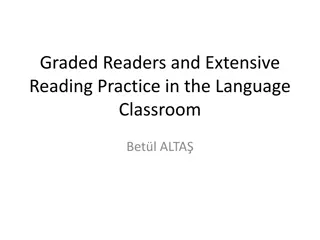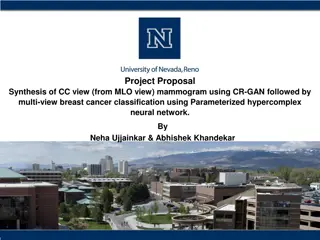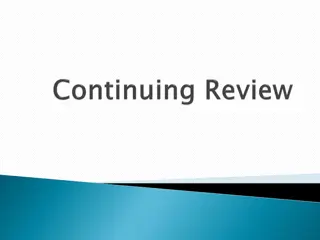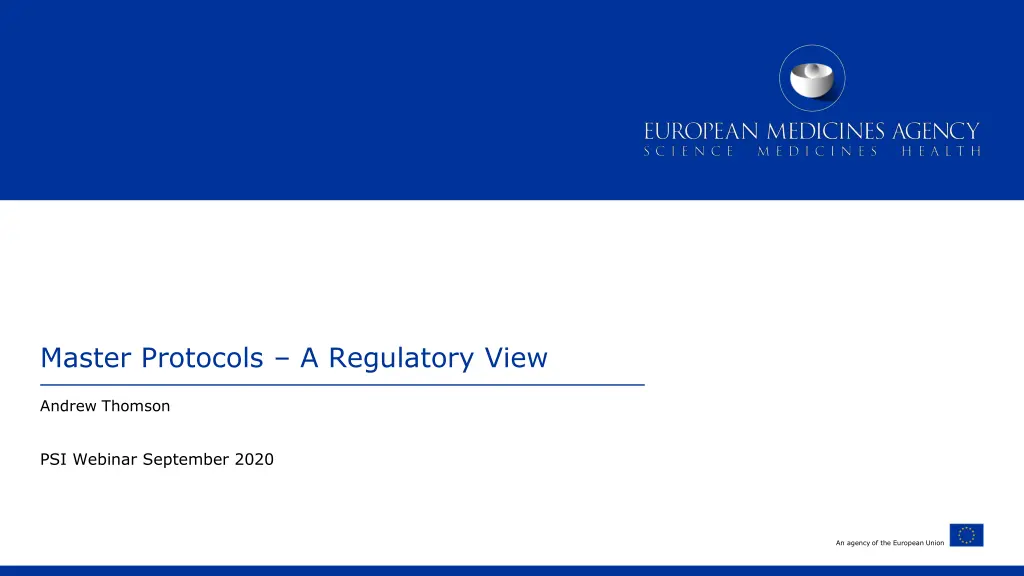
Regulatory Insights and Controls in Clinical Trials
Gain valuable insights into regulatory positions, error controls, concurrent controls, type I error management, and information leakage in clinical trials. Understand the implications of trial design choices on study integrity and regulatory impact. Presented by Andrew Thomson in a webinar hosted by an agency of the European Union.
Download Presentation

Please find below an Image/Link to download the presentation.
The content on the website is provided AS IS for your information and personal use only. It may not be sold, licensed, or shared on other websites without obtaining consent from the author. If you encounter any issues during the download, it is possible that the publisher has removed the file from their server.
You are allowed to download the files provided on this website for personal or commercial use, subject to the condition that they are used lawfully. All files are the property of their respective owners.
The content on the website is provided AS IS for your information and personal use only. It may not be sold, licensed, or shared on other websites without obtaining consent from the author.
E N D
Presentation Transcript
Master Protocols A Regulatory View Andrew Thomson PSI Webinar September 2020 An agency of the European Union
Disclaimer The views expressed are the personal views of the author and may not be understood or quoted as being made on behalf of or reflecting the position of the EMA or one of its committees or working parties. 1 Classified as public by the European Medicines Agency
Overview Regulatory positions and thoughts Concurrent Controls Type I Error Information leakage 2 Classified as public by the European Medicines Agency
Regulatory positions Neither of these are official EMA / CHMP / SAWP positions 3 Classified as public by the European Medicines Agency
Concurrent controls 4 Classified as public by the European Medicines Agency
Concurrent Controls Test 1 is compared to control subjects only from time epochs A and B Test 2 is compared to control subjects only from time epochs B and C This is non-negotiable Do we need a period effect? We know: In some conditions placebo response depends on whether the trial is active control Randomisation ratios can affect response Enrolled patient characteristics can change over time Some diseases change over time, especially infectious disease epidemics 5 Classified as public by the European Medicines Agency
Type I Error Control We can t be strict If Test 1 fails, then Test 2 does not have a chance? Why would Test 2 developer include their product in the platform? But we can t be lenient 2 doses of the same drug Why is dose different? We can hierarchically order doses. Knowledge of a successful lower dose implies (usually!) successful higher dose Converse is not true, hence hierarchy possible Independence of test arms is key incumbent upon developers to convince us 6 Classified as public by the European Medicines Agency
Information Leakage Perhaps not as widely appreciated Focus is on Interim Analyses (very common in these proposals) Different types of information Affects trials differently depending on the design chosen Regulatory impact depends on design chosen Hence why relevant to statisticians impact of trial design on study integrity 7 Classified as public by the European Medicines Agency
Example Event driven analyses Interim analysis (IA) after a certain number of events Events on test arm and control E.g. after 120 events on Test 1 + Control for the Test 1 IA After 120 events on Test 2 + Control for Test 2 IA Event is a bad outcome Pre-specified and the same for each arm Test of proportions 8 Classified as public by the European Medicines Agency
What does this mean in practice? Lets say we need 120 events to trigger the IA Success criteria is pre-defined such that 40 events on test and 80 events on control (or better) will be considered a success Test 1 reaches IA first and is a success Total events = 120, Total events on Control >=80 What do we know about Test 2? Total events < 120, Total events on Control >=80, Total events on Test 2 < Total events on Test 1. Test 2 is numerically better than Test 1. So is also significant. Test 2 will be better or as good as, at every possible analysis up until Test 2 + Control has 120 events. If Test 1 is positive, Test 2 is, and T1E is controlled 9 Classified as public by the European Medicines Agency
Conclusions in this case Not possible to have a SAP-defined stop as waiting for IA criteria to be met Even though we know Test 2 is better Information leakage is 100% Don t even need to know the actual results Just knowing Test 1 is positive is enough to infer Test 2 is If you have multiple arms numerically worst product wins first What happens if this become SoC so e.g. Test 1 replaces placebo as control What does Test 2 now need to beat? Sample size for non-inferiority v Test 1 >> Superiority versus placebo 10 Classified as public by the European Medicines Agency
Extending the case study Lets assume A = 2, B = 6 Test 1 reports out after 8 months Is a success What do we know about Test 2? Test 1 Test 2 2 months Control A B C 11 Classified as public by the European Medicines Agency
What do we know about Test 2? At the end of 8 months total (C=0, Test 2 studied for 6 months), not that much Lets take C = 2, i.e. Test 2 has been studied for 8 months Test 1 took 8 months If you want to make some assumptions: Uniform enrolment rate across epochs A and C Uniform event rates across A and C Then, you will conclude Test 2 is better Chance you might want to take, not guaranteed Data exists which can inform those assumptions enrolment rate (blinded) is relevant information for this analysis 12 Classified as public by the European Medicines Agency
Conclusions from this example Not 100% information leakage However, we may still have information about the trial which is relevant Enrolment rate matters Knowing the total number of events in a blinded fashion is informative With 3 arms, it tells you all, 4 or more, back to probabilities Even if you don t know the result of Test 1 v Control, you know the boundaries Make predictions with high accuracy and precision about Test 2 A clear plan about who has access to what data and when is crucial Sponsor? Platform Owner? Steering Committee? 13 Classified as public by the European Medicines Agency
Good v Bad events Example assumes event is a bad outcome death, disease progression, etc What if it is good? Improved symptoms within 28 days Everything is flipped around E.G. We need 80 events on Test and 40 events on Control What does this mean for the interim analysis? Back to simple scenario of 2 Test products starting at same time 14 Classified as public by the European Medicines Agency
Good events Interim Analysis 80 events on Test 1, 40 events on Control If the analysis is successful: We know the number of events on Test 2 + Control < 120 Number of events on Control =< 40 That s it! Can continue quite happily If the analysis is not successful, Test 1 continues, so Test 2 continues May raise question about futility of Test 2 numerically worse than Test 1 If Test 1 is futile, Test 2 is futile Information leakage although real, is not a regulatory risk 15 Classified as public by the European Medicines Agency
What other approaches might we have? Continuous outcomes Time-to-event instead of pure proportions Not the 100% guarantee of success, just very, very likely Interim analyses based on time epochs and not cases Potential for small amount of information between analyses (No small steps) Time based interim analyses with minimum information? Analyses every X weeks, as long as an additional Y cases have been observed? IAs based on total information i.e. after 160 cases across all arms Difficult unless all arms start at once 16 Classified as public by the European Medicines Agency
Conclusions on case studies The following sources of platform information may allow inferences to be drawn, or probabilities of success to be estimated, depending on the endpoint chosen and the design of the platform Whether one arm was successful or not The actual results if that arm was successful or otherwise Blinded event data without knowledge of treatment arm allocation Trial accrual rates Any changes in underlying disease throughout the study 17 Classified as public by the European Medicines Agency
Conclusions The more platforms we see, the more we learn Some regulatory positions are very well set Sometimes there are no easy answers There is no shortage of research opportunities to address these issues 18 Classified as public by the European Medicines Agency
Any questions? With Thanks to Benjamin Hofner and Lukas Aguirre D vila andrew.thomson@ema.europa.eu Official address Domenico Scarlattilaan 6 1083 HS Amsterdam The Netherlands Address for visits and deliveries Refer to www.ema.europa.eu/how-to-find-us Send us a question Go to www.ema.europa.eu/contact Telephone +31 (0)88 781 6000 Follow us on @EMA_News Classified as public by the European Medicines Agency



